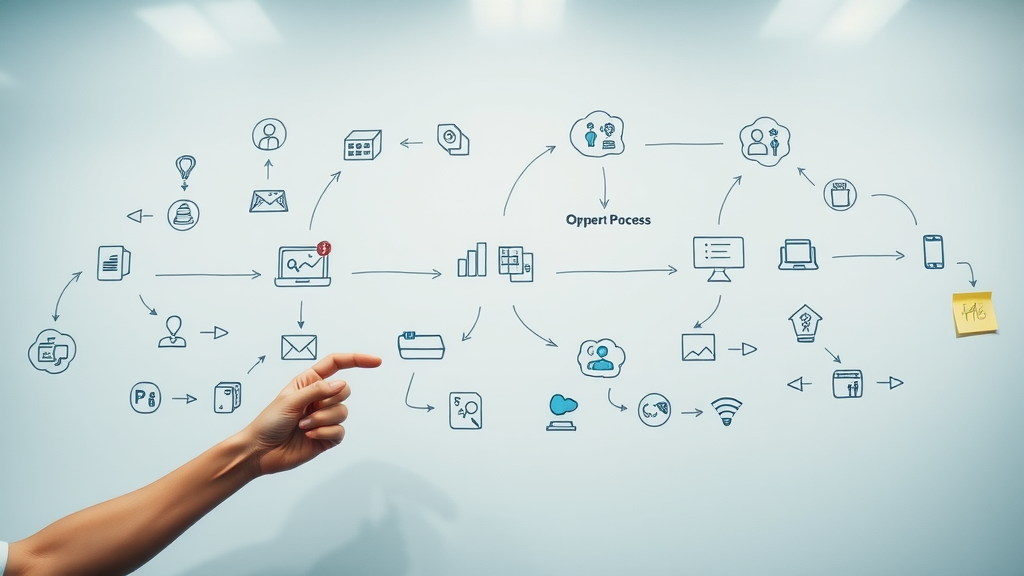Did you know that 96% of unhappy customers never complain directly —but nearly 91% of those will never return? Customer complaint management is not just about fixing problems—it's about turning dissatisfied customers into loyal advocates and protecting your brand’s bottom line. In today's connected world, managing customer complaints swiftly and strategically is more critical than ever to protect reputation, foster customer loyalty, and drive business growth. Dive into this comprehensive guide to discover how industry leaders transform complaints into opportunities and master the art of rapid issue resolution.
Transforming Customer Complaint Management: Surprising Data Every Business Leader Should Know
Customer complaint management is often underestimated in business strategies, yet it serves as a critical pillar for customer satisfaction , loyalty, and long-term success. Unpublished research reveals that while 96% of dissatisfied customers remain silent about their pain points, 91% of them will walk away, potentially spreading negative feedback via social media or word-of-mouth. This underlines why effective complaint management is more than a “nice-to-have”—it’s a core differentiator in today’s fiercely competitive landscape.
A good complaint management process doesn't simply resolve issues; it transforms negative experiences into brand advocacy. Companies that excel at managing complaints see a direct link to higher retention rates and increased revenue . Brands known for speedy, transparent issue resolution routinely convert critics into vocal promoters, influencing peers and boosting company credibility. In essence, mastering complaint management is not just about fixing problems—it's about fueling positive customer experiences.
Revealing the Unexpected Impact of Complaint Management on Customer Loyalty
- Learn why 96% of unhappy customers never complain directly, but 91% will never return.
- Explore how world-class complaint management elevates brand advocacy.
- Understand fast complaint resolution as a proven path to increased revenue.

Why Customer Complaint Management Should Be at the Core of Your Strategy
Placing customer complaint management at the heart of your business strategy can be a game-changer for growth and customer loyalty . With customers shifting between products and services at unprecedented rates, the way your business manages complaints directly impacts repeat business and online reputation. Leaders who view complaint management as more than just problem-solving recognize its power to drive innovation, inform product development, and distinguish their brand in a crowded marketplace.
A robust complaint management program not only addresses pain points but also uncovers valuable insights about your customers’ expectations and experiences. By analyzing complaint data and taking swift action, companies can implement strategic changes that resolve recurring issues and optimize the customer journey. This strategic orientation transforms complaint handling from a reactive task to a proactive driver of continuous improvement and business excellence.
Defining Customer Complaint Management and Its Role in Business Success
Customer complaint management encompasses the systematic process of capturing, tracking, resolving, and analyzing complaints from customers regarding your products and services. It acts as a bridge between dissatisfied customers and businesses seeking to maintain customer satisfaction, ensure loyalty, and foster positive brand image. A well-structured management process doesn't just solve immediate problems; it also provides critical data that helps businesses prevent similar issues, strengthen their service offerings, and improve overall customer experience.
Effective complaint management is more than a procedural step—it reflects a company's commitment to listening and responding with empathy and urgency. By prioritizing timely engagement and clear communication, your organization demonstrates accountability and builds trust, which are foundational for long-term customer relationships. In competitive markets, this proactive approach often distinguishes market leaders from those who fall behind.
Exploring the Essential Components of Effective Complaint Management
An effective complaint management program consists of multiple interconnected elements—each vital for ensuring a seamless customer experience. Begin with an accessible and straightforward reporting process, followed by rigorous documentation and categorization of each complaint. This guarantees that all relevant details are captured and can be analyzed for recurring patterns or potential systemic issues. Equipping your team with clear escalation protocols and automated notifications is essential to ensure timely responses.
Continuous training for customer service teams, alongside regular review of policies and processes based on complaint data, further strengthens your management system. Modern programs also employ customer feedback mechanisms and integrate with broader management software, ensuring organization-wide accountability. The result is a workplace culture that views complaints not as setbacks, but as valuable sources of information driving products and services forward.
Customer Complaint Management Systems: Structure and Best Practices
A well-defined customer complaint management system is the backbone of effective complaint handling. Whether you’re overseeing a small business or a large enterprise, the system you choose should ensure that every complaint—regardless of its origin—is captured, escalated, and resolved without falling through the cracks. Embedding a reliable system within your operations is fundamental to boosting customer satisfaction scores and protecting your brand’s reputation from avoidable negative reviews.
The best systems utilize a combination of user-friendly interfaces, automated tracking, and powerful analytics dashboards. These features streamline the entire process, providing your team with clear guidance on intake, investigation, and successful resolution. As customer expectations continue to rise, investing in the right system is no longer optional—it’s mission-critical for businesses striving for service excellence and ongoing improvement.
Core Features of a Robust Complaint Management System
- Complaint intake and documentation processes
- Automated tracking and customer notifications
- Integration with management software tools

Comparing Manual Versus Digital Customer Complaint Management Systems
Choosing between manual and digital systems for complaint management is a pivotal decision impacting both speed and accuracy in your management process . Manual systems, characterized by paper-based logs or basic spreadsheets, are prone to errors, slow data retrieval, and limited scalability. As businesses grow or complaint volumes increase, these pain points can bottleneck resolution, frustrate customers, and impede learning from complaint data.
In contrast, digital complaint management software offers streamlined workflows, real-time notifications, and integration capabilities with other business platforms. These solutions support automated tracking, accurate documentation, and advanced analytics for trend identification and root cause analysis. For companies striving for operational efficiency and excellence in customer complaint management , digital systems provide clear advantages—and future-ready scalability.
| Aspect | Manual System | Digital System |
|---|---|---|
| Speed | Slow | Fast |
| Scalability | Limited | Scalable |
| Tracking | Prone to error | Highly accurate |
End-to-End Complaint Management Process: Step-by-Step for Excellence
Successful customer complaint management hinges on a clearly defined, step-by-step process. Establishing repeatable procedures ensures that every complaint, no matter how small, is handled with the same attention and care. This minimization of variability across your teams creates consistency, accountability, and a higher degree of customer satisfaction .
Each step—from initial receipt to final customer follow-up—should focus on transparency and timely communication. A strong framework transforms chaos into order and equips your team to handle even complex scenarios. Businesses that invest in mapping and refining their complaint management process see measurable improvements in resolution times, satisfaction scores, and customer loyalty.
Mapping the Customer Complaint Management Process
- Receipt of complaint
- Documentation & categorization
- Investigation
- Resolution & customer engagement
- Follow-up and learning

Key Touchpoints in the Complaint Management Process
Effective management relies on recognizing and optimizing the critical touchpoints where complaints are received and acted upon. Each touchpoint is an opportunity to transform dissatisfaction into satisfaction—from the initial customer contact point (be it phone, email, in-person, or social media ) to follow-ups after resolution.
Consistent communication at each stage builds trust and reassures customers that their concerns are valued. Integrating technology-enriched touchpoints, like automated status updates and personalized responses, further enhances the customer experience . Whether addressing product, service, or policy complaints, investing in key touchpoints amplifies your organization’s reputation for reliability and care.
Types of Customer Complaints Every Management Program Faces
Understanding the various types of customer complaints is essential for designing a proactive management program . While every complaint feels unique to the customer, patterns often emerge—from product-related concerns to dissatisfaction with policies or staff. Recognizing these five primary categories enables businesses to allocate resources effectively and develop targeted strategies for resolution.
- Product dissatisfaction
- Service delays
- Staff behavior
- Policy disputes
- Other consumer complaints

Choosing the Right Complaint Management Software for Your Business
Selecting robust complaint management software is a major step in optimizing your customer complaint management program. The right solution centralizes complaints, automates key communications, and provides actionable insights through advanced analytics. With so many options available, the focus should be on features that eliminate manual bottlenecks and consistently drive better outcomes for both your team and your customers.
Software designed for complaint management often includes customizable workflows, detailed dashboards, and integrations with other management system platforms. These capabilities enable a seamless exchange of complaint data and customer feedback, ensuring no issue goes unresolved and every learning opportunity is harvested for continuous improvement.
Essential Features of Modern Complaint Management Software
- Real-time reporting
- Customer feedback integration
- Automated escalation
- Data analytics and dashboards
Top Reviewed Complaint Management Software Solutions: Pros and Cons
Today’s market offers comprehensive complaint management solutions like Zendesk, Freshdesk, and Salesforce Service Cloud. Each platform has unique strengths; Zendesk is renowned for its user-friendly interface and agile automation, while Salesforce excels in data analytics and integration. However, some companies find these platforms overly complex or expensive for small-scale needs, making ease of use, integration, and support important factors to weigh.

How a Strong Complaint Management Program Drives Customer Experience and Satisfaction
"The goal of effective complaint management is not only to resolve issues, but to turn negative events into opportunities for customer delight." – Industry Expert
A well-executed complaint management program directly shapes customer experience by demonstrating care, responsibility, and transparency in every interaction. When customers see their concerns handled efficiently, trust grows—and trust is at the heart of lasting relationships. Consistent follow-up and genuine engagement further cement the perception that your company values its customers beyond the initial transaction.
Companies with robust programs not only solve complaints effectively, but also convert former critics into brand ambassadors. This ripple effect magnifies positive word-of-mouth, impacting both retention and new business acquisition—especially in a world where consumers share their experiences widely online.
Case Studies: Transforming Customer Interaction Through Complaint Management
A major financial institution implemented an integrated digital complaint management system to automate intake, tracking, and resolution. As a result, their average response time dropped from days to hours—directly boosting customer satisfaction and security. Another retailer leveraged customer feedback analytics to identify repeating product issues, leading to design improvements, reduced complaint rates, and higher review scores within a single quarter.
These stories highlight how proactive complaint management programs—anchored in data, empathy, and swift action—can transform routine customer service into competitive advantage. Empower your team and business to see every complaint as both a challenge and an opportunity for leadership.

Capturing and Utilizing Complaint Data: Turning Feedback into Action
The secret to continuous improvement in customer complaint management lies in your ability to mine, analyze, and act on complaint data. Every complaint is a data point—an opportunity to uncover pain points, identify trends, and make informed business decisions. Relying on guesswork for improvement means missing out on actionable intelligence hiding in your complaint logs.
By integrating analytics tools and regular reporting, teams can benchmark performance, spot problem areas quickly, and pilot strategic changes. Complaint data, when paired with customer feedback from other channels, creates a comprehensive view of the customer journey and uncovers root causes that may otherwise go undetected.
Best Practices for Collecting and Analyzing Customer Feedback
Gathering meaningful customer feedback starts with removing barriers—offer simple, accessible channels for complaints through phone, web, email, and social media . Use structured intake forms that capture key details upfront, and always request follow-up surveys post-resolution. Adopt advanced analytics to cross-reference complaint topics, customer profiles, and resolution outcomes for deeper insights.
Review complaint data as part of regular business intelligence meetings. Encourage team members to spotlight recurring issues and propose targeted solutions. These practices transform feedback from a reactive defense mechanism into a proactive driver of product, service, and experience enhancements.
Leveraging Complaint Data for Continuous Improvement
Transforming complaint data into actionable insights is the cornerstone of a culture committed to continuous improvement . Build robust feedback loops by sharing findings across departments, including product development, marketing, and customer service. Use data visualizations and trend reports to build awareness and urgency for change at every level of the organization.
Forward-thinking companies regularly use complaint data to launch new training initiatives, revise outdated policies, or introduce more resilient product designs. This cycle of learning, adjusting, and following up ensures that the complaint management process becomes an engine for ongoing excellence—not just a fix for yesterday’s problems.
Training Your Team in Customer Complaint Management Excellence
Your team is at the front line of the customer complaint management process . Comprehensive training—both initial and ongoing—is essential for empowering staff to navigate tough conversations, defuse escalations, and deliver resolutions that build customer confidence. Top-performing companies invest heavily in skill-building, roleplay, and feedback to create a culture of empathy and accountability.
By equipping every team member with a deep understanding of the complaint management process and tools, you enable consistency and quality in every customer interaction. This not only supports efficient resolution but transforms customer service teams into brand ambassadors, reinforcing positive perceptions at every touchpoint.
Core Skills Required for Effective Complaint Handling
- Active listening
- Empathetic communication
- Problem-solving
- Follow-through and accountability

Designing Ongoing Training for the Complaint Management Process
Complaint management excellence is sustained through regular, dynamic training sessions that go beyond technical skills. Simulate real-world scenarios, debrief on complex cases, and foster peer-to-peer learning for stronger team cohesion and adaptability. Leverage feedback and complaint data to tailor sessions, ensuring evolving customer expectations and industry trends are addressed.
Develop clear pathways for staff to report best practices and suggest innovations. Regular training refreshers not only keep teams sharp but inspire employee engagement, resulting in more consistent, high-quality problem resolution across your organization.
Ensuring Customer Complaint Management Compliance and Risk Mitigation
Compliance is a non-negotiable aspect of modern complaint management , especially for industries handling sensitive data like banks, healthcare, and financial institutions. Effective programs are built on a foundation of legal and regulatory requirements aimed at safeguarding both consumer rights and company integrity. Non-compliance not only risks penalties—it dramatically impacts public trust.
Embed compliance checkpoints at each stage of the management process, ensuring privacy, documentation, and response timelines meet or exceed industry standards. Regular internal audits, automated alerts, and transparent reporting further reduce risk and signal a commitment to responsible complaint handling.
Legal and Regulatory Aspects of Managing Consumer Complaints
Laws such as the General Data Protection Regulation (GDPR) in Europe, and sector-specific mandates in healthcare and banking, outline strict rules for documenting, handling, and responding to consumer complaints. Staying current with regulatory changes is critical; even well-intentioned companies can stumble if procedures aren’t regularly reviewed and updated.
Training programs should include modules on legal compliance and industry-specific requirements. Making this knowledge accessible ensures every team member, regardless of role, understands the regulatory context for customer complaint management.
Protecting Customer Data in the Complaint Management Process
With increasing reports of data breaches, safeguarding sensitive information within your complaint management system is paramount. Strategies include robust access controls, end-to-end encryption, and regular system audits to identify vulnerabilities. Educate all team members on best practices for data security—not just IT professionals.
Demonstrating a commitment to protect customer data not only fulfills legal requirements but can become a core value proposition for your business. Customers are more likely to trust and engage with organizations that place security at the forefront of every interaction.

Measuring Success: KPIs for Effective Complaint Management
Evaluating your complaint management program hinges on robust, actionable KPIs. These metrics help you pinpoint problem areas, track progress, and continuously improve. Some of the most important KPIs for effective complaint management include:
- Resolution time
- Repeat complaint rates
- Customer satisfaction scores
- Net promoter score linked to complaint closure
By consistently reviewing these metrics, your organization can stay agile, adapt strategies where needed, and ensure that the complaint management process delivers real, measurable business value.
What is a customer complaint management system?
A customer complaint management system is a structured process and set of tools used to capture, track, resolve, and analyze complaints from consumers. It facilitates streamlined communication between customers and businesses, ensures issues are handled in a timely manner, and provides data that can drive improvements in products, services, and overall customer satisfaction.
How do you manage customer complaints?
To manage customer complaints effectively, quickly acknowledge the complaint, listen actively, investigate the situation thoroughly, resolve the issue to the customer’s satisfaction, and provide clear follow-up. Maintaining openness, empathy, and a solution-oriented approach are key in handling any complaint.
What are the 5 key factors of complaint handling?
The five key factors of complaint handling include: empathy and respect, timely and transparent communication, prompt issue resolution, thorough documentation of the complaint, and leveraging feedback for process improvement.
What 5-step process could you use to handle customer complaints?
A recommended 5-step process for customer complaint handling is: (1) Receive and acknowledge the complaint, (2) Investigate and assess the root cause, (3) Communicate solutions and expectations, (4) Implement the solution, and (5) Follow up to ensure satisfaction and document the outcome.
Frequently Asked Customer Complaint Management Questions
- What if a complaint cannot be resolved immediately? If a complaint can't be resolved right away, communicate honestly with the customer about the expected timeline for resolution. Provide regular updates, show empathy for their situation, and assure them their concern is a priority.
- How does management software support the process? Management software automates tracking, ensures documentation accuracy, triggers reminders for follow-up, and centralizes customer data. This streamlines communication, reduces manual errors, and allows faster resolution of complaints.
- When should complaints be escalated? Complaints should be escalated when they involve repeated issues, complex technical or legal matters, or when they can't be solved at the initial point of contact. Escalation helps ensure that more experienced staff or managers can intervene promptly to resolve the issue.
- Why is follow-up vital for customer satisfaction? Follow-up demonstrates respect and care for the customer by ensuring their issue was fully resolved. It builds trust, provides an opportunity for feedback, and can often turn a negative experience into a positive one that increases loyalty.
Level-Up Your Customer Complaint Management for Strategic Growth
"Every complaint is a chance to show your brand’s reliability and turn critics into supporters."
Every business will face complaints, but the way your organization responds defines your reputation and future success. By elevating your customer complaint management program, you turn obstacles into momentum for growth. Focus on data, technology, training, and compliance, and watch customer loyalty soar.

Ready to Transform Your Complaint Management Program?
Tired of being overlooked online because of weak or missing reviews? Let us help you implement a custom review strategy that works. Book your free consultation today!
Action Steps: Start by evaluating your current complaint management system, invest in robust complaint management software, and prioritize staff training for excellence. Monitor KPIs, embrace compliance, and remember: each complaint is a valuable opportunity for improvement and growth.
 Add Row
Add Row  Add
Add 




Write A Comment